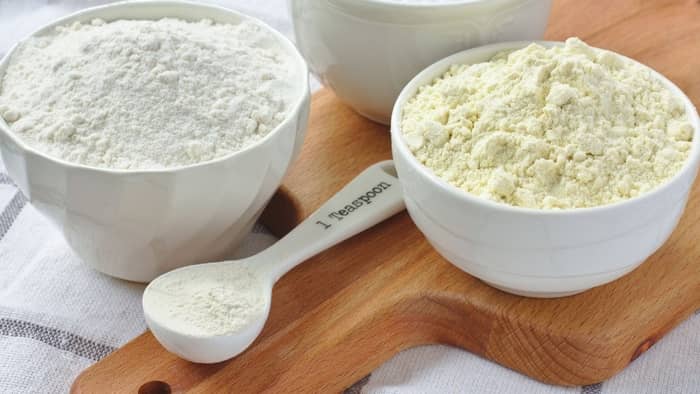Last Updated on February 24, 2023
Today, we’re going to be answering the question: should you be using xanthan gum instead of cornstarch? Let’s take a look at their differences and uses! But first, we’ll look at what they are and why they’re important when following a gluten-free lifestyle. If you’ve been following this lifestyle for a while, you’ll certainly have noticed them in the ingredients of many gluten-free products you’ve bought.
What Is Xanthan Gum?
Xanthan gum is an additive you’ll find in a large amount of gluten-free products. It’s main uses are thickening products and as a stabilizer. Gluten is often used as a thickener, so xanthan gum is a great substitute. Like many thickeners, it does not provide any nutrients. Xanthan gum is essentially fermented sugar. A mix of the sugar and an alcohol are left to dry and they form a powder – xanthan gum.
Like many thickeners, xanthan gum is able to change shelf life, flavor and texture in food products, among other products. It’s main use in gluten-free cooking is to bring light and fluffiness.
You may notice xanthan gum in products such as:
- soups
- sauces
- gravy
- baked goods
- many gluten-free foods
What Is Cornstarch?
Cornstarch is another thickener and stabilizer you’ll often see in gluten-free products, predominantly. Even though it’s derived from a grain; the grain is corn, and completely gluten-free. By removing the outer bran from a corn kernel, cornstarch is born.
Again, cornstarch is able to change flavor, texture, and consistency in food products, among other things. It’s also good at absorbing water.
Cornstarch’s uses are very similar to that of xanthan gum:
- stews
- sauces
- gravy
- many gluten-free foods
Cornstarch vs Xanthan Gum
As with most things, there are pros and cons to using both. Let’s take a closer look!
Xanthan Gum
Xanthan gum hosts a range of benefits. It’s great for lowering blood sugar levels as it’s absorbed slowly. It also helps to lower blood pressure and even cholesterol levels. For fiber levels, it’s a really good addition to your diet; it can help soften stools and can improve your bowel movements. Xanthan gum has zero calories.
While it is the better option, xanthan gum is extremely expensive in comparison to cornstarch. We’ll take a look at shop-bought products later.
However, like most products high in fiber – it can cause some gut/digestive issues. It can cause symptoms such as:
- increase in flatulence
- loose stools
- change in gut bacteria
- abdominal cramps
- bloating
Cornstarch
Cornstarch is great for a balanced diet, but should not be eaten in large quantities. This is because it’s full of calories and carbohydrates, which are not good if eaten too often. For this reason, it has also been linked to weight gain – so make sure if you’re using cornstarch, that it’s in moderation.
However, like xanthan gum, it’s good for lowering blood sugars – so if you’re diabetic as well or have problems with your heart, these two thickeners are perfect for you. Cornstarch is also much more accessible than xanthan gum and a far cheaper alternative.
The main point to remember when using either is to use both in moderation, as both have unwanted side effects if eaten too regularly and in excess. If you’re looking for a store that sells both cornstarch and xanthan gum, Trader Joe’s is a great place to start.
Cornstarch To Xanthan Gum Ratio

Read more about: Are All Pretzels Gluten Free?
Good news! Whether you want to use cornstarch or xanthan gum – the ratio is exactly the same; 1:1. Whatever a recipe requires for cornstarch, just use the same amount of xanthan gum. However, it’s important to note that xanthan gum can quickly become globular and it’s hard to reverse this – so add it slowly until you’ve built the consistency up to how you’d like it.
Where To Buy
Cornstarch
Many of your local grocery stores will sell cornstarch and it will usually be at a pretty unbeatable price. Cornstarch in stores like Walmart range from $1-$10, depending on the size and brand.
Argo is an affordable option, that displays a gluten-free label. It’s vegan, no sugar, no sodium, and of course, gluten-free. It’s around $2 for a 16oz jar. Cornstarch is the only ingredient.
You can find a range of cornstarch products available here.
Xanthan Gum
Xanthan gum may be harder to find in your local grocery stores – but don’t worry, it’s easily accessible online if you can’t find it. As it’s the more expensive option, prices range from $5-$20. Again, all dependent on the brand and size you require.
Namaste Foods is one of the more inexpensive options on offer and is certified gluten-free. This means it’s been through vigorous testing and has met the guidelines supplied by FDA for gluten-free certification. It’s free from the top eight allergens, which means it’s allergen-friendly and is also organic. It’s around $7 for an 8oz packet. Xanthan gum is the only ingredient.
You can find a variety of xanthan gum products here.
Which Is Best?
Although xanthan gum is pricier than cornstarch, if you’re able to buy it, I would highly recommend it. Whenever I’ve used it in baking, my baked goods are lighter, fluffier, and also full of goodness. However, cornstarch is probably better if you’re looking to thicken stews or sauces.
It’s important to note that if you live in Europe, xanthan gum is far more accessible and cheaper to obtain.
Conclusion
To conclude, depending on your financial situation and what you’re trying to gain from your diet, either is suitable as there aren’t too many differences between them. Gluten-free life can already feel overwhelming enough without me telling you which thickener you should be using! Whichever works for you is the most important thing – and in moderation.
What do you usually reach for in gluten-free cooking/baking? I would love to know which you think works best and why. Please feel free to leave any answers in the comments below.
Read more about: Is Yeast Extract Gluten Free?

Hi, my name’s Zoë. I’m 28 years old and live in London, UK. I work full time as a freelance writer and critic for West End theatre. Writing has been a passion of mine for as long as I can remember. I spend most of my free time at the theatre, or at conventions. I’m married to the love of my life, and live in a small apartment with my fur baby, Lillie. I run two of my own blogs: No Safer Place and Stage to Page: both of which have won awards. I also have a YouTube channel where I talk about all things stagey.


